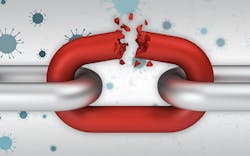Ways Home Builders Can Manage Material Availability Risk
The coronavirus has dominated the news, plagued the stock market, and afflicted the global supply chain. Factory output in China, Italy, and Japan has plummeted as some plants have been, and remain, closed while others are operating at greatly reduced capacity—and the full impact of the global supply chain disruption has yet to be felt.
Existing domestic inventory of building products and additional inventory on the ocean that shipped before the outbreak has delayed the impact to building product distributors, installing trades, and, ultimately, home builders. But that won’t last forever.
There are some immediate steps you can take as a purchasing and supply chain professional to minimize your risk. These actions include increasing material requirements visibility to your trades and their suppliers and identifying high-risk materials, alternate sources and brands, encouraging trades to take an inventory position, and eliminating slow-moving material that isn't readily available in the supply chain from your design studio.
RELATED
- Now Is a Good Time to Review and Refresh Your Materials Supply Chain: Use this guide to identify and prequalify suppliers to reinvigorate and stabilize your supply chain
- Supplier Survival: Adopt a Highly Differentiating Approach: Suppliers can inspire builders to think beyond ‘first cost’ to total cost (and even total value)
Identify Which Building Materials Are at Risk
The first thing you should do is identify which specific materials are at risk. Think labor-intensive items that ship well, specifically ones with little or no domestic manufacturing capacity. Examples include decorative lighting, door hardware, stair rail parts, smoke detectors, carbon monoxide detectors, LVT/LVP, and electronic components.
That last one affects more products than you may realize. Think about every product in a home that has electronic components: appliances, video doorbells, garage door openers, furnaces, air conditioners, fireplaces, door locks, breakers, LED bulbs, light switches, outlets, and ventilation fans, among several others—all of which are potential high-risk items.
Also consider this: I recently talked with 56 manufacturers and 74% of them either import their electronics from China or import components for those products from China.
You may not be able to eliminate your risk altogether, but there are some immediate steps you can take as a purchasing and supply chain professional to minimize your risk.
Get with your manufacturer sales reps to find out where their products—and even components for those products—are manufactured. This is not something they traditionally needed to know, so it's surprising that they are not intimately knowledgeable about it.
For example, I talked with one manufacturer who assured me they would not have any supply concerns as their product is made in Mexico. As I pressed him about electronic components, he discovered that all of them came from a plant in China that has been down two weeks longer than planned and is now operating at a diminished capacity.
Home Builders Should Engage Their Trades
To determine which items are high risk for you, share your material requirements with your trades and suppliers, and provide the full backlog if you can.
This is an area where having detailed material requirements in your computer system is a competitive advantage. Turnkey contracts simply do not provide you with the specific SKU level details that you need to manage through an inventory crisis. That’s a big reason why I believe “lump sum is dumb” because it can’t tell you anything truly worthwhile.
Ask your trades to work with their suppliers to help you identify high risk material SKU’s in your backlog.
Home Builders Need to Find Alternative Sources of Supply for Building Materials
Next, identify alternative sources of supply, including a different stocking distributor or a competitive brand that is manufactured in the U.S, or an unaffected (or less-affected) country.
The key here is to start early, before you have a stock-out situation. You won’t be the only one who is looking for alternative sources of supply. I began this process as soon as I heard of the coronavirus outbreak in China, and I was the first to call many of the manufacturers. However, as I have continued communicating with them over the subsequent weeks, they have shared that other builders are also reaching out. Be the first to tie up the remaining inventory in the channel.
Another reason to start early is that some alternative sources of supply may have longer lead times than your current source of supply.
Home Builders Should Share the Risk With Trades
As you or your trades identify high-risk materials and distributors with materials in stock, see if your installing trades are willing to take an inventory position.
As material availability becomes an issue, distributors will sell to the highest bidder. I experienced this phenomenon with roof shingles years ago when storms were ravaging the East Coast. Best to purchase the material now and store it than risk not having everything you need to build through a supply disruption.
With that, be willing to make a commitment to your trades as it relates to using those materials. They will be more willing to work with you if they know they will not get stuck with the materials when the dust settles.
With Some Materials in Short Supply, It's Time to Hone Specs
For those of you who have read my articles, you know how I feel about the benefits of minimizing SKUs and targeting SKUs to those that are readily available in your supply chain.
For those of you who were able to do that, you have an advantage over those who haven’t as you work to minimize the risk associated with any supply disruption.
The first material SKUs hit are those slow-moving materials not stocked in distribution. If you haven't been able to reduce and target your SKUs, consider giving it another try. It will help you navigate through this and the next supply chain constraint.
Involve your design studio in that effort. There may be high-risk materials that they need to exclude from your option catalog. It makes no sense to continue selling materials you can’t get. Best to know and pull the materials from your option line-up before it leads to a negative customer experience.
Also, have a conversation with your trades about everything in your options catalog. Options should be included in their risk assessment. This is important, as some of your high-risk items may not be in your backlog now but are one option sale away from getting there.
Home Builders Need to Think Globally About the Supply Chain
In this increasingly global marketplace, purchasing and supply-chain professionals will face new challenges. The coronavirus is just one example of how truly dependent we are on other countries for manufacturing capacity.
The best strategy is to be proactive. Avoid burying your head in the sand thinking that somehow everything will be alright. Remember, luck favors the prepared mind.
You may not be able to eliminate your risk altogether, but you can minimize it with some effort and by following these simple steps.


